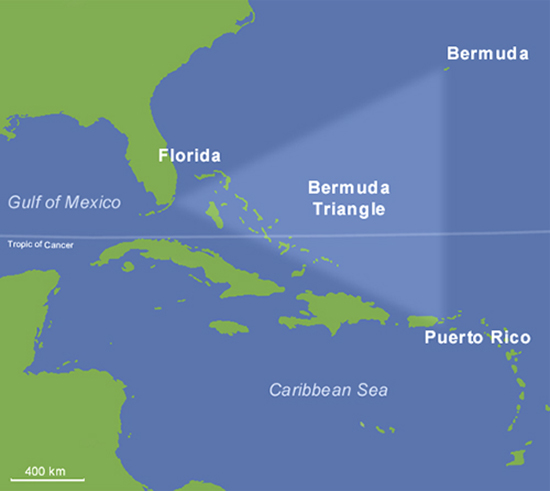Methane Hydrates
An explanation for some of the disappearances focuses on the presence of vast fields of methane hydrates on the continental shelves. A paper was published by the United States Geological Survey about the appearance of hydrates in the Blake Ridge area, offshore southeastern United States, in 1981. Periodic methane eruptions are capable of producing ship-sized bubbles, or regions of water with so much dissolved gas, that the fluid density is no longer capable of providing adequate buoyancy for ships to float. If this were the case, such an area forming around a ship could cause it to sink almost directly and without warning. Experiments have proven that a methane bubble can indeed sink a ship by decreasing the density of the water.
Methane gas can also crash planes. The less dense air causes planes to lose lift. Also, the altimeter of planes (the instrument that measures the altitude) functions on the density of air. Because methane is less dense, the altimeter assumes the plane is climbing. Planes at night or in the clouds, where they can't see the ground, assume that they are climbing and dive, causing them to crash. Also, methane in the engine throws off the mix of fuel and air. Aircraft engines burn hydrocarbons (gasoline or jet fuel) with oxygen provided by the air. When the ambient oxygen levels drop, combustion can stop, and the engine stalls. All of these effects of methane gas have been shown experimentally.
Laboratory experiments carried out in Australia have proven that bubbles can, indeed, sink a scale model ship by decreasing the density of the water; any wreckage consequently rising to the surface would be rapidly dispersed by the Gulf Stream. It has been hypothesized that periodic methane eruptions (sometimes called "mud volcanoes") may produce regions of frothy water that are no longer capable of providing adequate buoyancy for ships. If this were the case, such an area forming around a ship could cause it to sink very rapidly and without warning.
A white paper was published in 1981 by the United States Geological Survey about the appearance of hydrates in the Blake Ridge area, off the southeastern United States coast. However, according to a USGS web page, no large releases of gas hydrates are believed to have occurred in the Bermuda Triangle for the past 15,000 years.
Hurricanes
Hurricanes are extremely powerful storms which are spawned in the Atlantic near the equator, and have historically been responsible for thousands of lives lost and billions of dollars in damage. The sinking of Francisco de Bobadilla's Spanish fleet in 1502 was the first recorded instance of a destructive hurricane. In 1988, Hurricane Gilbert, one of the most powerful hurricanes in history, set back Jamaica's economy by three years. These storms have in the past caused a number of incidents related to the Triangle.
Gulf Stream
The Gulf Stream is an ocean current that originates in the Gulf of Mexico, and then through the Straits of Florida, into the North Atlantic. In essence, it is a river within an ocean, and like a river, it can and does carry floating objects. A small plane making a water landing or a boat having engine trouble will be carried away from its reported position by the current, as happened to the cabin cruiser Witchcraft on December 22, 1967, when it reported engine trouble near the Miami buoy marker one mile (1.6 km) from shore, but was not there when a Coast Guard cutter arrived.
Freak Waves
Extremely large waves can appear seemingly at random, even in calm seas. One such rogue wave caused the Ocean Ranger, then the world's largest offshore platform, to capsize in 1982. There is, however, no particular reason to believe rogue waves are more common in the Bermuda region, and this explanation cannot account for the loss of airplanes.
Research has shown that freak waves up to 30 m (100 feet) tall, capable of sinking the largest ships within moments, can and do happen. Although these are very rare, in some areas ocean currents mean they happen more often than the norm. Such waves have now been hypothesized as a cause for many unexplained shipping losses over the years.
The book was a best seller, and many interested readers offered theories to explain the nature of the disappearances. The list includes natural storms, transportation by extraterrestrial technology, high-traffic volumes (and correspondingly high accident rates), a "temporal hole," the lost Atlantis empire from the bottom of the ocean, and other natural and supernatural causes.
Aerial photos taken in 2005 show the phenomenon of glowing water. Whatever causes this phosphorescence to vent up from the Bahama Bank bottoms, if that is its cause, remains a mystery.
The Triangle's location in the Caribbean makes it subject to unpredictable weather patterns. This takes us to Earth changes and the excalation of intense hurricanes in 2005 with more to come in the years ahead.
These weather extremes prey on inexperienced navigators and smaller boats and planes. Water spouts, sudden electrical and thunder storms, and the like, can cause havoc in the area. The Gulf Stream can also be brutal in that region and perhaps has swept away evidence of natural disasters.
Electronic Fog
Many people have reported seeing portals opening in cloudy skies - strange
swirling lights sometimes accompanied by sounds - temporal distortions - electromagnetic distortions called 'electronic fog' that can cause a time storm, and the disappearance of planes and ships. There is something about this fog that is important and gives one the sense of all things paranormal. Something unexplained is definitely happening in that region of the Atlantic. This goes back to ancient explorers such as Christopher Columbus and his crew who experienced the phenomenon.


